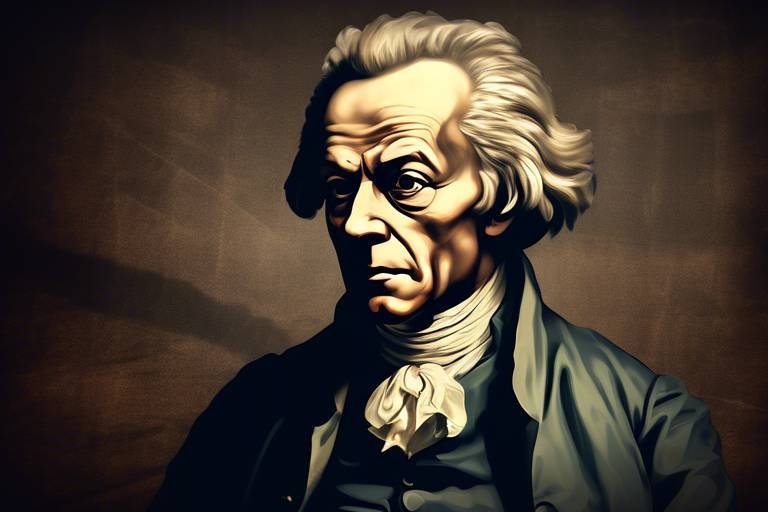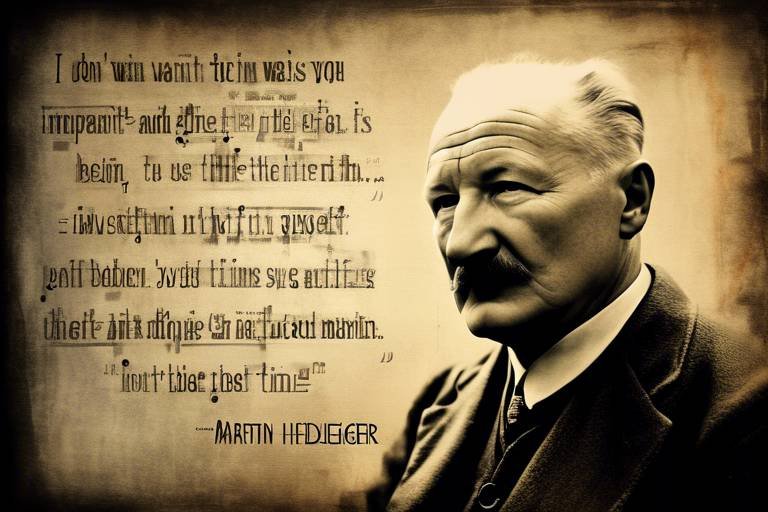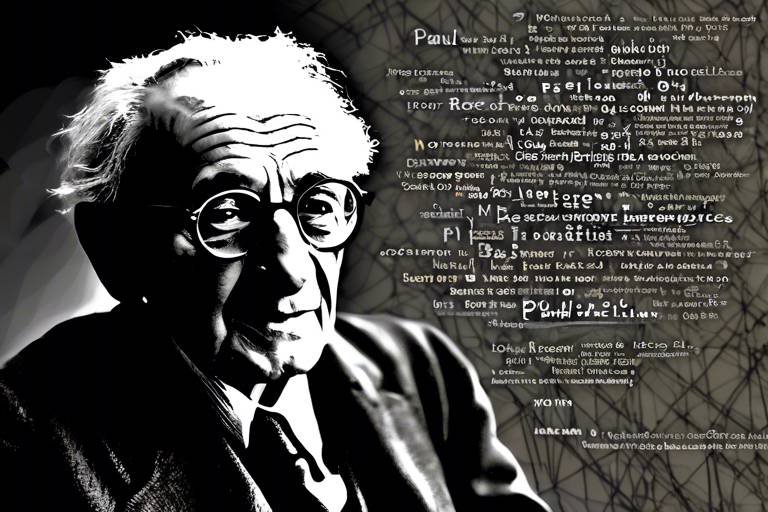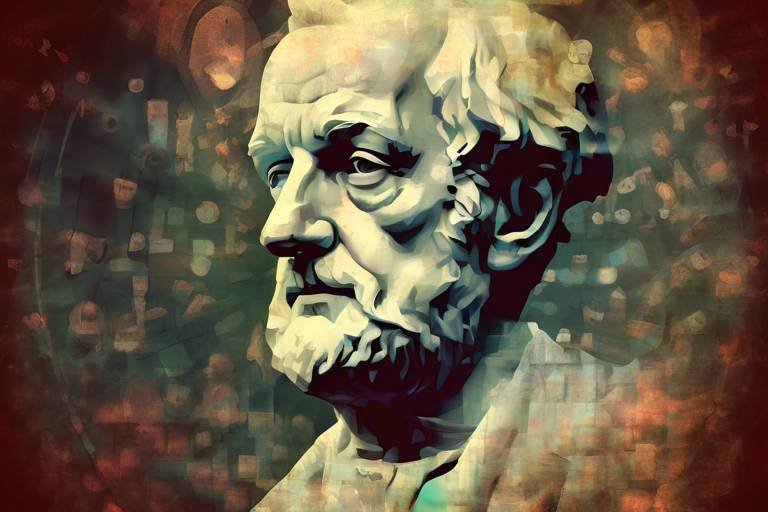Exploring Zeno's Paradoxes - More than just Puzzles?
When you first hear about Zeno's paradoxes, you might think of them as mere brain teasers, fun riddles that tickle the mind. However, these ancient puzzles are far more than just intellectual exercises; they are profound inquiries into the very fabric of reality, motion, and infinity. Formulated by Zeno of Elea in the 5th century BCE, these paradoxes challenge our intuitive understanding of space and time, and they have sparked discussions that resonate through the corridors of philosophy, mathematics, and physics even today.
Imagine running a race where you can never quite catch up to your opponent, no matter how fast you are. This is the essence of Zeno's famous paradoxes. They force us to confront uncomfortable questions about the nature of movement and continuity. The implications of these paradoxes stretch far beyond the realms of ancient thought; they challenge modern science and philosophy to reconsider how we define and understand progress and completion.
One might wonder, why do these paradoxes continue to hold such significance in contemporary discourse? The answer lies in their ability to provoke critical thinking and inspire new ideas. From the development of calculus to debates in modern metaphysics, Zeno's paradoxes have acted as a catalyst for intellectual growth. They invite us to explore the boundaries of our understanding and to question the very nature of reality.
As we delve deeper into Zeno's paradoxes, we will uncover their historical context, the philosophical motivations behind them, and the ongoing relevance they hold in today's discussions about motion and infinity. Are these paradoxes mere curiosities, or do they hold the key to unlocking deeper truths about our universe? Join us as we explore this captivating topic and unravel the mysteries that Zeno left behind.
- What are Zeno's paradoxes? Zeno's paradoxes are a set of philosophical problems formulated by Zeno of Elea that challenge our understanding of motion and infinity.
- Why are they important? They provoke critical thinking and have influenced various fields including philosophy, mathematics, and physics.
- How do Zeno's paradoxes relate to modern science? They have led to advancements in calculus and continue to inspire debates in metaphysics and epistemology.
- Can Zeno's paradoxes be resolved? Yes, mathematicians have developed tools like calculus to address the challenges posed by these paradoxes.

The Origins of Zeno's Paradoxes
Zeno of Elea, a philosopher from ancient Greece, was born around 490 BC and is best known for his paradoxes that challenge our understanding of motion and infinity. His work emerged during a time when Greek philosophy was blossoming, and thinkers were beginning to grapple with profound questions about existence, reality, and the nature of the universe. Zeno was a student of the philosopher Parmenides, who famously argued that change and motion are mere illusions. Zeno's paradoxes were crafted as arguments to support Parmenides' views, pushing the boundaries of philosophical discourse in ways that still resonate today.
At the core of Zeno's paradoxes lies a fundamental challenge: how can motion occur if it seems to involve traversing an infinite number of points? This question not only perplexed Zeno's contemporaries but has continued to baffle philosophers and mathematicians through the ages. His paradoxes, such as "Achilles and the Tortoise" and the "Dichotomy Paradox," serve to illustrate the contradictions inherent in our understanding of space and time. Zeno's work sparked a rich dialogue among philosophers, leading to various interpretations and debates about the nature of reality.
To better understand Zeno's motivations, it's essential to consider the philosophical context of his time. The ancient Greeks were deeply interested in the nature of being and existence, and Zeno's paradoxes can be seen as a response to the prevailing beliefs about the world. His paradoxes are not merely intellectual exercises; they challenge the very foundations of how we perceive movement and continuity. In fact, Zeno's arguments can be viewed as a precursor to modern discussions in metaphysics and mathematics.
Throughout history, Zeno's paradoxes have influenced various philosophical movements, prompting thinkers to revisit the concepts of infinity, continuity, and the nature of reality. The legacy of Zeno's work is evident in the way it has shaped discussions in both philosophy and mathematics. As we explore these paradoxes further, we begin to see their relevance not just as ancient puzzles, but as enduring questions that continue to provoke thought and discussion in contemporary discourse.
In summary, Zeno's paradoxes are much more than mere curiosities; they are profound challenges to our understanding of motion, space, and time. They invite us to question our assumptions and reconsider the nature of reality itself, making them a vital part of the philosophical landscape. As we dive deeper into Zeno's most famous paradoxes, we will uncover the intricate layers of thought that have emerged around these compelling ideas.

Key Paradoxes Explained
Zeno's paradoxes are not just brain teasers; they are profound challenges to our understanding of reality. These paradoxes, particularly the most famous ones like Achilles and the Tortoise and the Dichotomy Paradox, force us to confront the complexities of motion, distance, and time. Each paradox presents a unique problem that has sparked debate among philosophers and mathematicians for centuries, revealing the intricate relationship between infinity and continuity.
In the paradox of Achilles and the Tortoise, we find a scenario where Achilles, a swift runner, races against a tortoise that has a head start. Zeno argues that Achilles will never be able to overtake the tortoise, regardless of how fast he runs. Why? Because every time Achilles reaches the point where the tortoise was, the tortoise has moved a little further ahead. This leads to an infinite series of points that Achilles must reach, suggesting that motion itself is an illusion. The paradox raises critical questions about the nature of distance and time, as it challenges our intuitive understanding of how we perceive movement.
At the heart of Zeno's paradoxes lies the idea of infinite divisibility. This concept posits that any given distance can be divided into an infinite number of smaller segments. Imagine slicing a pizza into infinitely thin slices; no matter how many times you cut it, there will always be more pieces to cut. This notion leads to a troubling conclusion: if every distance can be divided infinitely, how can we ever truly complete a journey? Zeno's paradoxes force us to reconsider our understanding of continuity and discreteness, challenging the very foundations of motion.
The implications of Zeno's paradoxes extend far beyond mere puzzles. They challenge traditional notions of motion and change, prompting philosophers and mathematicians alike to rethink the principles governing our universe. For centuries, thinkers have grappled with these ideas, leading to significant developments in both philosophy and mathematics. The paradoxes have encouraged a deeper exploration of concepts such as time, space, and the nature of reality. As we delve into the realm of motion, we find ourselves questioning whether our perceptions of speed and distance truly reflect the complexities of the world around us.
Another intriguing paradox is the Dichotomy Paradox, which posits that before reaching any destination, one must first cover half the distance to that destination. But before covering half the distance, one must cover a quarter of the distance, and before that, an eighth, and so on. This creates an infinite regression of steps that seems to suggest that movement is impossible. If we can never complete an infinite number of tasks, how can we ever arrive at our destination? This paradox raises profound questions about the nature of progress and completion, inviting us to reconsider how we perceive our journeys through life.
In summary, Zeno's paradoxes are not merely intellectual exercises; they are gateways to deeper philosophical inquiry. They challenge our understanding of the universe and compel us to explore the boundaries of human perception and reasoning. As we unravel the complexities of these paradoxes, we gain insights that resonate across disciplines, from mathematics to philosophy and beyond.
- What are Zeno's paradoxes? Zeno's paradoxes are a set of philosophical problems formulated by Zeno of Elea that challenge our understanding of motion, distance, and infinity.
- Why are they important? They have influenced philosophical thought and mathematical developments, prompting discussions about the nature of reality and the foundations of mathematics.
- How do mathematicians resolve these paradoxes? Through the development of calculus and the concept of limits, mathematicians have provided frameworks to understand motion in a finite manner despite the infinite divisibility suggested by Zeno.

Achilles and the Tortoise
The paradox of is one of Zeno's most captivating and perplexing illustrations that challenges our understanding of motion and time. Imagine this: Achilles, a swift and powerful warrior, is racing against a tortoise that has a head start. On the surface, it seems like a no-brainer; Achilles, with his incredible speed, should easily overtake the slow-moving tortoise. However, Zeno argues otherwise, leading us into a fascinating realm of philosophical inquiry.
To break it down, Zeno posits that in order for Achilles to catch up to the tortoise, he must first reach the point where the tortoise started. But by the time Achilles reaches that point, the tortoise has moved a little further ahead. This process repeats infinitely: every time Achilles reaches the previous position of the tortoise, the tortoise has advanced slightly. Thus, Zeno concludes that Achilles can never actually overtake the tortoise, regardless of how fast he runs. This paradox raises profound questions about the nature of distance and time, making us rethink what we consider to be possible.
At its core, this paradox introduces the concept of infinite divisibility. Zeno suggests that any distance can be divided into an infinite number of smaller segments. Consider the following breakdown:
| Step | Achilles' Position | Tortoise's Position |
|---|---|---|
| Start | 0 meters | 10 meters |
| After 1st Segment | 10 meters | 11 meters |
| After 2nd Segment | 11 meters | 11.1 meters |
| After 3rd Segment | 11.1 meters | 11.2 meters |
This table illustrates how, at every stage, Achilles is always catching up but never quite reaching the tortoise. It’s a mind-bending scenario that forces us to confront our intuitions about motion. Does this mean that motion is an illusion? Or is there something deeper at play here? The implications of Zeno's paradox extend beyond mere mathematics; they touch on the very fabric of reality as we perceive it.
Furthermore, this paradox has sparked numerous debates among philosophers and mathematicians throughout history. Many have attempted to resolve the contradiction by introducing concepts such as limits and calculus, which help bridge the gap between infinite series and finite results. However, the enduring nature of Zeno's paradox invites us to continuously ponder the complexities of motion, time, and existence.
In essence, the Achilles and the Tortoise paradox does more than just challenge our understanding of speed and distance; it invites us into a deeper conversation about the nature of reality itself. Are we merely observers in a universe governed by paradoxes, or do we possess the tools to unravel these intricate puzzles? As we explore these questions, we find ourselves drawn into the rich tapestry of philosophical thought that Zeno has woven through the ages.

The Concept of Infinite Divisibility
The notion of infinite divisibility is a cornerstone of Zeno's paradoxes, fundamentally challenging our understanding of space, time, and motion. Imagine trying to traverse a distance; Zeno suggests that before you can reach your destination, you must first cover half the distance. But then, before you can cover that half, you must cover a quarter of the distance, and so on. This leads to an endless series of divisions, making it seem impossible to ever actually arrive at your destination. It’s like trying to reach the horizon—no matter how far you go, there’s always more ground to cover.
This concept raises profound questions about the nature of reality and our perception of motion. If every distance can be divided infinitely, how can we claim to move from point A to point B? It’s almost as if Zeno is playing a game of mental gymnastics, twisting our intuitions into knots. To illustrate this, let’s consider a simple example:
| Step | Distance Remaining |
|---|---|
| Start | 1 unit |
| After 1st Step | 0.5 units |
| After 2nd Step | 0.25 units |
| After 3rd Step | 0.125 units |
| After n Steps | 1/(2^n) units |
As we can see from the table, with each step, the distance remaining decreases but never quite reaches zero. This paradox is not merely an intellectual exercise; it forces us to confront the very nature of continuity and discreteness in our universe. Are we truly moving, or is motion just an illusion created by our perception?
Philosophers and mathematicians alike have wrestled with these ideas for centuries. The implications of infinite divisibility extend beyond just Zeno’s paradoxes. They challenge the foundations of calculus and raise questions about the very fabric of reality. For instance, if we consider the concept of a line drawn on a page, we might think of it as infinitely divisible into smaller segments. Yet, in practical terms, we can only measure it to a certain precision. This tension between theory and practice creates a fascinating dialogue about how we understand our world.
Ultimately, Zeno's paradoxes and the idea of infinite divisibility urge us to reflect on our assumptions about motion and change. They remind us that the world is not always as straightforward as it seems, inviting us to explore deeper philosophical questions about existence and perception. So, the next time you think about taking a step forward, remember Zeno’s paradoxes and the intricate dance of infinity that lies beneath the surface of our everyday experiences.
- What are Zeno's paradoxes? Zeno's paradoxes are a set of philosophical problems formulated by Zeno of Elea, which challenge our understanding of motion and infinity.
- How does infinite divisibility relate to Zeno's paradoxes? Infinite divisibility suggests that any distance can be divided into infinitely smaller segments, raising questions about the nature of motion and progress.
- Why are Zeno's paradoxes still relevant today? They continue to provoke thought and discussion in philosophy, mathematics, and physics, influencing modern theories about time and space.

Implications for Motion
Zeno's paradoxes are not just mere intellectual exercises; they have profound implications for our understanding of motion. When we think about motion, we often assume it's a straightforward concept—something that happens when an object changes its position over time. However, Zeno's paradoxes challenge this intuitive notion, forcing us to re-evaluate what we mean by movement and how we perceive it. For instance, in the famous Achilles and the Tortoise paradox, we are led to believe that Achilles can never overtake the tortoise, despite his superior speed. This raises an intriguing question: if motion is continuous, how can it be that Achilles is perpetually behind? This paradox highlights the complexities of distance and time, suggesting that our everyday experiences of motion might be built on shaky philosophical ground.
Furthermore, Zeno's paradoxes introduce the concept of infinite divisibility, where any distance can be divided into an infinite number of smaller segments. Imagine trying to walk from one end of a room to the other. According to Zeno, before you can reach the far wall, you must first cover half the distance, then half of that half, and so on ad infinitum. This notion leads to a seemingly absurd conclusion: if there are infinitely many steps to take, how can we ever complete the journey? This paradox not only challenges our understanding of motion but also forces us to confront the nature of infinity itself.
The implications of these paradoxes extend beyond philosophy and mathematics; they touch on the very fabric of reality as we perceive it. For example, consider how we measure time. If motion consists of an infinite series of steps, does that mean time is also infinitely divisible? This creates a fascinating conundrum: can we ever truly experience a moment in time, or are we always moving through an endless series of instants? This question has implications for both our understanding of physics and our everyday experiences.
Moreover, Zeno's paradoxes have prompted mathematicians and philosophers to explore new frameworks for understanding motion. The development of calculus, particularly the concept of limits, has provided a way to reconcile these paradoxes with our observable reality. By introducing limits, mathematicians can analyze motion in a finite way, allowing us to understand how objects move through space without falling into the traps set by Zeno's reasoning. This shift not only resolves some of the paradoxes but also enriches our understanding of concepts like velocity and acceleration.
In essence, Zeno's paradoxes compel us to confront the fundamental questions about the nature of motion, time, and space. They encourage a deeper exploration of how we understand the world around us, pushing the boundaries of both philosophical inquiry and mathematical reasoning. The dialogue initiated by Zeno's work continues to resonate in contemporary discussions, as we grapple with the implications of motion in both theoretical and practical contexts.
- What are Zeno's paradoxes? Zeno's paradoxes are a set of philosophical problems formulated by Zeno of Elea that challenge our understanding of motion and infinity.
- How do Zeno's paradoxes relate to modern mathematics? They have influenced the development of calculus and the concept of limits, which help to reconcile the paradoxes with observable reality.
- Why are Zeno's paradoxes still relevant today? They continue to spark debates in philosophy, mathematics, and physics, prompting us to reconsider fundamental concepts such as time, space, and motion.

The Dichotomy Paradox
The Dichotomy Paradox is one of Zeno's most fascinating and perplexing challenges to our understanding of motion and progress. Imagine you're about to embark on a journey to a destination, let’s say, a coffee shop just down the street. Before you can even take a step toward that coffee shop, Zeno argues that you must first cover half the distance to it. Once you've covered that half, you still have to cover half of the remaining distance, and so on, ad infinitum. This leads to an infinite regression of steps that seemingly prevents you from ever reaching your destination. It’s as if you’re caught in a never-ending loop, always moving but never arriving. Isn’t that a head-scratcher?
This paradox raises profound questions about the very nature of progress and completion. How can we reconcile the act of moving forward with the idea that we must first traverse an infinite number of smaller distances? It challenges our intuitive understanding of motion, suggesting that if every journey requires an infinite number of steps, then how can anyone ever truly reach their goal? To illustrate this concept further, consider the following:
| Step | Distance Covered | Remaining Distance |
|---|---|---|
| 1 | 1/2 | 1/2 |
| 2 | 1/4 | 1/4 |
| 3 | 1/8 | 1/8 |
| 4 | 1/16 | 1/16 |
| ... | ... | ... |
As shown in the table above, with each step, the distance covered gets smaller and smaller, yet the remaining distance never quite reaches zero. This paradox can be likened to trying to fill a bathtub with a leaky faucet; no matter how much water you pour in, the leaks will always keep it from being full. The Dichotomy Paradox compels us to rethink our assumptions about space and time, leading to deeper philosophical inquiries.
In essence, Zeno's Dichotomy Paradox isn't just a puzzle; it's a reflection of the complexities inherent in our understanding of reality. It invites us to explore the limits of our concepts of distance and motion, pushing us to consider how we perceive the world around us. Are we merely traversing an infinite series of steps, or do we have the capacity to leap from one point to another? This paradox remains a focal point for discussions in both philosophy and mathematics, illustrating the intricate dance between theory and our lived experience.
- What is the Dichotomy Paradox?
The Dichotomy Paradox posits that before reaching a destination, one must first cover half the distance, leading to an infinite regression of steps.
- How does the Dichotomy Paradox challenge our understanding of motion?
It suggests that if every journey requires an infinite number of steps, then reaching a goal becomes an impossible task.
- Why is the Dichotomy Paradox important in philosophy?
It raises fundamental questions about the nature of reality, progress, and our perceptions of time and space.

Mathematical Responses to Zeno
Zeno's paradoxes have long puzzled thinkers, and while they might seem like mere intellectual exercises, they actually provoke serious questions about the nature of motion and reality. Thankfully, mathematicians have stepped up to the plate to tackle these paradoxes head-on, developing a variety of approaches that help clarify our understanding. One of the most significant advancements in this area is the development of calculus, which has provided the tools necessary to bridge the gap between infinite divisibility and finite outcomes.
At the heart of calculus lies the concept of limits. This mathematical tool allows us to analyze what happens as we approach a particular value, even if we never actually reach it. For instance, when we consider the distance Achilles must cover to overtake the tortoise, we can express this distance as a series of steps that progressively get smaller. By applying limits, we can sum these infinite steps and arrive at a finite conclusion, showing that Achilles does indeed overtake the tortoise after all.
To illustrate this concept further, let's consider a simple example. Imagine a runner who needs to cover a distance of 100 meters. According to Zeno's paradox, before the runner can reach the finish line, they must first cover half the distance (50 meters), then half of that (25 meters), and so on. This creates an infinite series of distances. However, using the formula for the sum of an infinite geometric series, we can calculate the total distance covered:
| Step | Distance Covered (m) | Remaining Distance (m) |
|---|---|---|
| 1 | 50 | 50 |
| 2 | 25 | 25 |
| 3 | 12.5 | 12.5 |
| 4 | 6.25 | 6.25 |
| 5 | 3.125 | 3.125 |
| ... | ... | ... |
| Total | 100 | 0 |
As we can see from the table, while the distances become infinitely smaller, the total distance converges to 100 meters. This is the beauty of calculus—it allows us to make sense of Zeno's infinite regressions in a way that aligns with our intuitive understanding of motion.
Moreover, modern mathematicians have also explored set theory and real analysis to further dissect Zeno's paradoxes. These fields provide a rigorous framework for understanding concepts like infinity and continuity, allowing us to engage with Zeno's ideas from a fresh perspective. For instance, the notion of a real number line helps us visualize how points can be infinitely close to one another, thereby resolving some of the confusions surrounding motion and distance.
In conclusion, Zeno's paradoxes may have originated in ancient Greece, but they have sparked a rich dialogue that has persisted through the ages. The mathematical responses to these paradoxes not only shed light on the nature of motion but also demonstrate the power of human ingenuity in tackling complex problems. As we continue to explore these ideas, we find that Zeno's paradoxes remain relevant, challenging us to think deeply about the world around us.

Calculus and Limits
When we dive into the world of calculus, we find ourselves equipped with powerful tools that allow us to tackle the challenges posed by Zeno's paradoxes. At its core, calculus introduces the concept of limits, which provides a way to understand how we can approach infinity without actually reaching it. Imagine you're trying to get to the end of a long hallway. Each step you take gets you closer, but what if you could only ever take half of the remaining distance with each step? This is where the beauty of calculus comes into play, as it helps us make sense of these seemingly impossible scenarios.
Calculus, developed by great minds like Isaac Newton and Gottfried Wilhelm Leibniz, allows us to analyze changes in quantities and understand motion in a finite manner. Through the use of limits, we can examine what happens as we approach a certain point or value. For instance, when we say that the limit of a function as it approaches a particular value equals a specific number, we are essentially saying that even if we never actually reach that number, we can understand its behavior as we get infinitely close. This concept is crucial in resolving the paradoxes that Zeno presented.
To illustrate this further, let’s consider the Achilles and the Tortoise paradox. In this scenario, Achilles is racing a tortoise that has a head start. Zeno argues that Achilles can never overtake the tortoise because every time he reaches the point where the tortoise was, the tortoise has moved a little further ahead. However, calculus tells us that the sum of these infinite distances can actually converge to a finite number. This convergence is expressed mathematically through the concept of limits, allowing us to calculate the exact moment Achilles overtakes the tortoise.
Here’s a simplified breakdown of how limits work in this context:
| Step | Distance Covered by Achilles | Distance Covered by Tortoise |
|---|---|---|
| 1 | 0.1 meters | 0.01 meters |
| 2 | 0.01 meters | 0.001 meters |
| 3 | 0.001 meters | 0.0001 meters |
| 4 | 0.0001 meters | 0.00001 meters |
As we can see, each step Achilles takes covers a smaller and smaller distance, while the tortoise also moves forward, albeit at a slower pace. The magic of limits shows us that while there are infinitely many steps, the total distance Achilles needs to cover is finite. Thus, he will eventually catch up with the tortoise, and the paradox is resolved!
In summary, calculus and limits provide a framework that allows us to understand the complexities of motion and distance in a way that Zeno's paradoxes initially seem to defy. By using these mathematical concepts, we can bridge the gap between the infinite and the finite, and ultimately, unravel the intricate dance of motion that defines our universe.

Modern Interpretations
In the ever-evolving landscape of philosophy and mathematics, Zeno's paradoxes continue to capture the imagination of thinkers and scholars alike. These ancient puzzles have transcended their historical context, finding new life in the realm of modern interpretations. Today, philosophers and mathematicians are not just pondering the implications of Zeno's ideas; they are actively engaging with them to explore the very fabric of reality, time, and infinity.
One of the most significant modern interpretations revolves around the concept of non-standard analysis. This mathematical framework allows for the treatment of infinitesimals—quantities that are closer to zero than any standard real number but are not zero themselves. By employing this approach, mathematicians can navigate through the infinite divisions proposed by Zeno without falling into the traps of paradox. This perspective reshapes our understanding of motion, suggesting that it is indeed possible to traverse infinite points in a finite time, thereby resolving the tension between Zeno's conclusions and our physical experiences.
Moreover, contemporary discussions often delve into the implications of Zeno's paradoxes on the nature of time itself. Modern physics, particularly in the context of relativity, challenges the classical notions of time as a linear continuum. Instead, time is viewed as a more complex, intertwined dimension of the universe. This shift in perspective leads to fascinating questions: Is time truly divisible, or is our perception of motion merely a construct of our consciousness? As we explore these questions, Zeno's paradoxes serve as a critical lens through which we can examine the limits of our understanding.
Another area of exploration is the intersection of Zeno's paradoxes with quantum mechanics. At the quantum level, particles exhibit behaviors that seem to defy classical logic, including the ability to exist in multiple states simultaneously. This phenomenon resonates with Zeno's ideas about infinite divisibility and the challenges of defining motion. The paradoxes prompt scientists to reconsider how we define progress and completion in a universe that operates on principles that often seem counterintuitive.
As we engage with these modern interpretations, it becomes clear that Zeno's paradoxes are not merely academic exercises but rather profound inquiries into the nature of existence. They compel us to ask deeper questions about how we perceive reality, the limits of our knowledge, and the intricate dance between mathematics and philosophy. In a world where new discoveries continuously reshape our understanding, Zeno's paradoxes remain a cornerstone for critical thinking, inspiring both awe and curiosity.
- What are Zeno's paradoxes? Zeno's paradoxes are a set of philosophical problems formulated by Zeno of Elea in ancient Greece, challenging our understanding of motion, time, and infinity.
- How do modern mathematicians interpret Zeno's paradoxes? Modern mathematicians use frameworks like non-standard analysis and calculus to address the infinite divisibility proposed by Zeno, providing solutions that align with contemporary understanding of motion.
- What impact have Zeno's paradoxes had on philosophy? Zeno's paradoxes have profoundly influenced philosophical thought, prompting discussions about reality, perception, and the nature of time and space, shaping key movements throughout history.
- Are Zeno's paradoxes relevant today? Yes, Zeno's paradoxes continue to be relevant as they inspire ongoing debates in mathematics, physics, and philosophy, encouraging deeper inquiry into fundamental concepts.

The Philosophical Impact of Zeno's Paradoxes
Zeno's paradoxes are more than mere intellectual curiosities; they have left a profound mark on the landscape of philosophical thought. These paradoxes challenge our understanding of reality, perception, and the very limits of human cognition. Imagine standing at the edge of a vast chasm, where each step forward seems to lead you into an infinite regression of smaller and smaller steps. This is the essence of Zeno's thought experiments, which have spurred centuries of debate and inquiry.
Historically, Zeno's paradoxes significantly influenced ancient philosophers, particularly Plato and Aristotle. Plato, in his dialogues, grappled with the implications of these paradoxes on his theory of forms and the nature of existence. He pondered whether the world of appearances could ever truly reflect the reality of the forms, especially when faced with the paradoxical implications of motion and change. Aristotle, on the other hand, sought to refute Zeno's arguments. He emphasized the continuity of motion and introduced the concept of potentiality and actuality, suggesting that while Zeno's paradoxes challenged conventional thinking, they also provided a foundation for deeper philosophical exploration.
In modern philosophy, Zeno's paradoxes continue to be a focal point for discussions surrounding time, space, and infinity. Contemporary philosophers often refer to these paradoxes in debates about metaphysics and epistemology. For instance, some argue that Zeno's paradoxes illustrate the limitations of our intuitive understanding of motion, while others see them as a precursor to modern discussions in physics, particularly in quantum mechanics and relativity, where the nature of time and space is still a topic of intense study.
To further understand the philosophical impact of Zeno's paradoxes, consider the following key areas:
- Reality and Perception: Zeno’s paradoxes compel us to question how we perceive reality. Are our intuitions about motion and distance reliable, or do they lead us astray?
- The Nature of Infinity: The paradoxes challenge our understanding of infinity, prompting discussions about whether infinity is a concept that can be fully grasped or if it remains an abstract notion.
- Limits of Human Understanding: Zeno's work underscores the limitations of human reason. How do we reconcile our logical frameworks with the complexities of the universe?
In summary, Zeno's paradoxes serve as a bridge between ancient and modern philosophical thought. They not only challenge our understanding of fundamental concepts but also encourage ongoing dialogue about the nature of existence itself. As we continue to explore these paradoxes, we find that they resonate across disciplines, from philosophy to mathematics to physics, highlighting their enduring relevance in contemporary discourse.
- What are Zeno's paradoxes? Zeno's paradoxes are a set of philosophical problems formulated by Zeno of Elea, which challenge our understanding of motion and infinity.
- How did Zeno influence ancient philosophers? Zeno's paradoxes prompted significant discussions among ancient philosophers like Plato and Aristotle, impacting their theories on motion and existence.
- Are Zeno's paradoxes still relevant today? Yes, they remain a topic of interest in modern philosophy, mathematics, and physics, influencing contemporary debates about time and space.

Influence on Ancient Philosophy
Zeno's paradoxes were not just intellectual gymnastics; they were profound challenges that stirred the minds of ancient philosophers. His ideas, particularly those surrounding motion and infinity, forced thinkers like Plato and Aristotle to reevaluate their understanding of reality. Imagine being a philosopher in ancient Greece, where the world is perceived through the lens of tangible experiences. Zeno's paradoxes would feel like a pebble thrown into a still pond, creating ripples of thought that would challenge the very foundation of existence.
Plato, for instance, was intrigued by the implications of Zeno's arguments. He sought to reconcile the paradoxes with his theory of Forms, which posited that the material world is just a shadow of a higher reality. Zeno's work pushed him to explore deeper questions about the nature of reality and perception. It is as if Zeno handed Plato a riddle that he couldn't quite solve, leading him to ponder the essence of existence itself.
On the other hand, Aristotle took a more pragmatic approach. He aimed to dismantle Zeno's arguments by introducing the concept of potential infinity, suggesting that while distances can be divided infinitely in theory, they do not have to be so in practice. Aristotle's rebuttals were not merely dismissals; they were attempts to ground philosophical inquiry in observable reality. This back-and-forth between Zeno and Aristotle sparked a rich dialogue that would influence subsequent philosophical thought.
Moreover, the ripple effects of Zeno's paradoxes extended beyond individual philosophers. They laid the groundwork for critical discussions about motion, time, and space in ancient philosophical schools. The debates that emerged from Zeno's challenges can be summarized as follows:
- The Nature of Motion: Is motion an illusion, or is it a fundamental aspect of reality?
- Infinity and Continuity: How do we reconcile the concept of infinity with our finite experiences?
- Perception vs. Reality: How do our perceptions shape our understanding of existence?
These questions not only enriched philosophical discourse in ancient times but also set the stage for future explorations in metaphysics and epistemology. Zeno's paradoxes, therefore, were not mere puzzles; they were foundational stones that shaped the trajectory of philosophical inquiry for centuries to come. As we reflect on these ancient debates, we can see how they continue to resonate with modern thought, reminding us that the questions posed by Zeno are as relevant today as they were in ancient Greece.
- What are Zeno's paradoxes? Zeno's paradoxes are a set of philosophical problems formulated by Zeno of Elea that challenge our understanding of motion and infinity.
- How did Zeno influence ancient philosophers? Zeno's paradoxes prompted philosophers like Plato and Aristotle to rethink their ideas about reality, motion, and existence.
- Are Zeno's paradoxes still relevant today? Yes, Zeno's paradoxes continue to inspire discussions in modern philosophy, mathematics, and physics.
- What is the significance of infinite divisibility? Infinite divisibility suggests that distances can be divided indefinitely, leading to complex implications for understanding motion and continuity.

Modern Philosophical Debates
In the contemporary landscape of philosophy, Zeno's paradoxes continue to spark vibrant discussions, challenging our understanding of time, space, and infinity. Philosophers today grapple with the implications of these paradoxes, often finding themselves at a crossroads between ancient wisdom and modern scientific advancements. The questions raised by Zeno are not just relics of the past; they are alive and well, influencing various fields of thought.
One of the core debates centers around the nature of continuity and discreteness. Zeno's paradoxes suggest that if space and time are infinitely divisible, then how can we ever truly arrive at a destination? This has led to fascinating discussions in both metaphysics and epistemology. For instance, some modern philosophers argue that our perception of motion and change is fundamentally flawed, while others posit that advancements in physics, such as quantum mechanics, might offer new insights into these age-old dilemmas.
Moreover, the concept of infinity has taken on new meanings in light of mathematical developments. The advent of set theory and the understanding of different sizes of infinity have prompted philosophers to reconsider Zeno’s arguments. The challenge now is not just to resolve the paradoxes but to understand their implications in a world that increasingly embraces complexity and uncertainty.
Additionally, the debate extends to the realm of consciousness and perception. How do we experience motion? Is it a seamless journey, or is it a series of discrete moments? This question is particularly relevant in the context of modern cognitive science, which investigates how our brains process time and space. Philosophers are now asking whether Zeno's paradoxes might reveal more about human cognition than about the physical world itself.
In summary, the implications of Zeno's paradoxes resonate deeply in modern philosophical discourse, encouraging a reevaluation of foundational concepts. The intersection of ancient philosophy with contemporary scientific thought creates a rich tapestry of inquiry, where the past informs the present and vice versa. As we delve deeper into these discussions, we find ourselves not only questioning the nature of reality but also our own understanding of existence.
- What are Zeno's paradoxes? Zeno's paradoxes are a set of philosophical problems formulated by Zeno of Elea that challenge our understanding of motion, space, and infinity.
- How do Zeno's paradoxes relate to modern science? Modern scientific theories, particularly in physics and mathematics, provide frameworks that address and attempt to resolve the issues raised by Zeno's paradoxes.
- Why are Zeno's paradoxes still relevant today? They provoke ongoing debates in philosophy regarding the nature of reality, perception, and the limits of human understanding, making them timeless topics of discussion.
Frequently Asked Questions
- What are Zeno's paradoxes?
Zeno's paradoxes are a set of philosophical problems formulated by Zeno of Elea in ancient Greece. They challenge our understanding of motion, space, and time, presenting scenarios that seem to contradict common sense. For instance, in the famous Achilles and the Tortoise paradox, Achilles cannot overtake a tortoise that has a head start, despite being faster, raising questions about infinite divisibility and distance.
- Why are Zeno's paradoxes significant in philosophy?
Zeno's paradoxes have significantly influenced philosophical thought by prompting deep discussions about the nature of reality, motion, and infinity. They have shaped key philosophical movements and inspired thinkers like Plato and Aristotle to explore the implications of motion and existence, leading to a richer understanding of these concepts.
- How do mathematicians respond to Zeno's paradoxes?
Mathematicians have developed various approaches to resolve Zeno's paradoxes, particularly through the introduction of calculus and the concept of limits. These mathematical tools help bridge the gap between infinite divisibility and finite outcomes, allowing for a better understanding of motion and progress in a way that aligns with our everyday experiences.
- What is the Dichotomy Paradox?
The Dichotomy Paradox posits that in order to reach a destination, one must first cover half the distance, then half of the remaining distance, and so on, leading to an infinite regression of steps. This paradox raises intriguing questions about the nature of progress and completion, challenging our perceptions of how we move through space.
- Are Zeno's paradoxes still relevant today?
Absolutely! Zeno's paradoxes continue to be relevant in contemporary discussions in philosophy, mathematics, and physics. Modern philosophers and mathematicians explore new interpretations of these paradoxes, reflecting advancements in science while still grappling with the fundamental questions Zeno posed about time, space, and infinity.



















